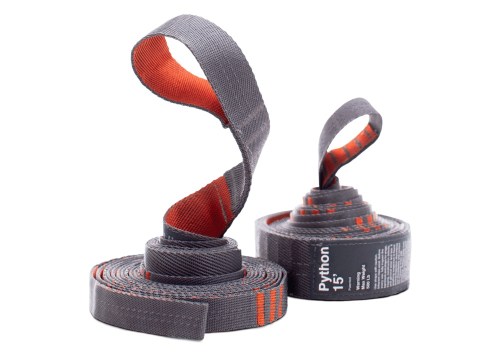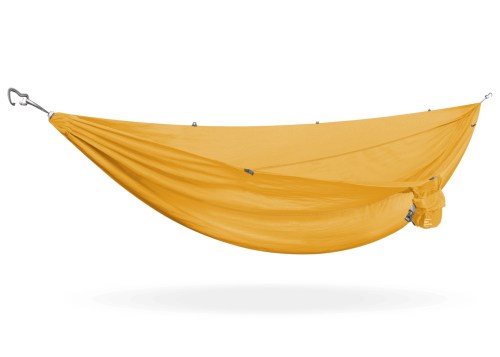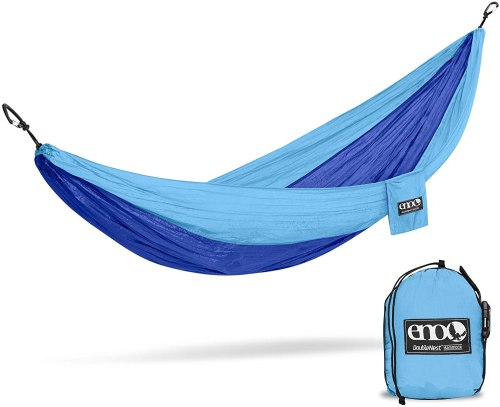Our editors independently select these products. Making a purchase through our links may earn Well+Good a commission
The Best Portable Hammock—And How To Hang It Up Securely
Enjoy hammocking in your backyard or a nearby park. Shop the best portable hammocks and straps and learn how to hang one up.

Every time I pass someone resting serenely and securely in a portable hammock, I’m intrigued. As someone who isn’t very outdoorsy, the idea that you can just tie a hammock to some trees, hop in, and have it just stay in place seems like sorcery. But hammock expert Kathy Schertz, product coordinator at REI, says anyone can do it and everyone should do it. She loves to take her hammock to the trails near her home in Washington.
Experts in This Article
Kathy Schertz is the product coordinator at sports and recreation store REI.
“There’s a spectacular waterfall just up on one of the trails that’s walking distance from my house,” she says. “One of the things that I love to do is to walk up there, take my hammock, and go off trail a little bit—carefully, so I’m being respectful of nature and following leave no trace principles and all of that. And just put my hammock up in the trees and listen to the water. I’ll take a snack. Sometimes I’ll take a book. Sometimes I’ll put music on. Sometimes I’ll just listen to the birds. And sometimes I’ll take a little nap.”
Even if you don’t have a waterfall within minutes from your home, you can enjoy a hammock in your backyard or a nearby park. Below, Schertz shares the best portable hammocks. Grab one (or more—Schertz owns several hammocks so she always has one to share with friends) and then keep reading to learn the right way to hang a portable hammock.
Best portable hammock straps
First things first, you need straps. Schertz says to always use straps, never cable or rope to hang a hammock. “Those things can cut into the bark and end up damaging the tree and that’s definitely not what you want to do,” she says. Once you get a good pair of straps, they can be used with any hammock no matter the brand.

Kammok Python 15 — $39.00
These tree-friendly straps are Schertz’s go-to. They’re made from a high-tenacity polyester webbing that’s 1.5 inches wide to ensure there’s no stretch in your straps, holding you steady. “When you’re putting it around a tree, that webbing and that width of webbing is going to reduce any damage to the bark and damage to the tree.

ENO Atlas Hammock Straps — $29.00
Schertz also recommends the ENO Atlas Hammock Straps. These straps suspend hammocks between trees 10′ that are to 14′ apart.
Best portable hammocks
When selecting a hammock, Schertz says it’s best to use a double hammock, even if you plan to primarily hammock solo.
“Double has more fabric width-wise,” she says. “I like the width because when I’m laying in my hammock, one of the things that people do when they first climb into a hammock is they’ll lay perfectly in line from one end to the other. But to be more comfortable, you want to cant yourself, you want to go at an angle across it. And so having more fabric, for me, just makes it more comfortable. I can stretch out a little bit more.”

Kammok Roo Double — $79.00
The Kammok Roo Double is Schertz’s go-to hammock. It can safely support up to 500 pounds and is complete with a cup holder to keep your water bottle close. It comes in 12 colors including pine green, sunflower gold (pictured), and midnight blue. Note to hover over the name of the colors and click through all of the product images to see what they actually look like as the sample symbols don’t fully align with the true colors. If you don’t want the double, you can shop the Roo Single ($69).

ENO DoubleNest Hammock — $70.00
Schertz also enjoys the hammocks from ENO. The ENO DoubleNest holds up to 400 pounds and comes in 33 different color combinations.

Hennessy Hammock Explorer Deluxe Asym Zip Hammock — $195.00
Schertz also recommends Hennesy Hammocks, which offers hammocks that come with a separate hammock tent, perfect for camping. It comes with a set of cords and webbing straps to protect the bark of trees.
How to safely hang a portable hammock
1. Double check that you’re in an area where you’re allowed to hammock
“Be aware of what the requirements and what the rules are in the area that you’re going to be in,” says Schertz. “Some campgrounds that you’re in have specific no hammock rules. And that’s to prevent damage to vegetation and from people doing things that are inappropriate and not taking care of the environment. So being aware of what those rules are is really important.” Of course, lookout for signs that deter hammocking, but also look out for fragile flowers and plants that you could damage by walking over/falling onto.
2. Secure a safe space
Just in case, you want to make sure that you’re setting up in a space where you’ll be okay if you fall out.
“When you first get used to climbing into a hammock, there are some of those kind of funny fails, that you flip over and you slip out, and you look around quickly and go, ‘Okay, did anybody see that?'” says Schertz. “Make sure that you’re not over top of sharp rocks or things that if you were to fall, you could be seriously injured. Now that said, I have put my hammock up in some areas that, yeah sure, if I fell out, I would have some bruises. But the scenery and the location was worth it for me. And I felt comfortable doing that.”
3. Find well-spaced sturdy supports
Schertz says you want sturdy supports that are spaced 10 to 15 feet apart from each other. They can be anything from trees and posts to boulders. “You have to have a sturdy foundation,” she says. With trees, you want to make sure they’re healthy and alive —you don’t wanna risk damaging or pulling over a tree. Schertz has even used her car as support. “I have a Nissan Xterra, and it has a brush guard on the front,” she says, “and I’ve attached from the rail on my brush guard on the front of my Xterra and to a tree.”
4. Attach your straps
All you need to hang your hammock is straps and the hammock. Follow your strap’s instructions to loop your straps to the tree—no fancy knots required. Your hammock should come with carabiners (those metal loops that open and close) that you attach to your straps. Make sure the carabiners are properly attached by making sure the gate, the part that hinges open is closed, and if you have a locking carabiner, that it’s properly locked, says Schertz.
Hang your hammock so once you get in it’s no higher than 18 inches from the ground. Even if you want to sit at an angle, attach your straps at even heights. You can shift up and down in the hammock to change the angle you’re sitting at.
Oh hi! You look like someone who loves free workouts, discounts for cult-fave wellness brands, and exclusive Well+Good content. Sign up for Well+, our online community of wellness insiders, and unlock your rewards instantly.
Sign up for the Well+Good SHOP Newsletter
Get exclusive deals on wellness, beauty, fitness, and food products that have been hand-picked by our editors.
Got it, you've been added to our email list.









